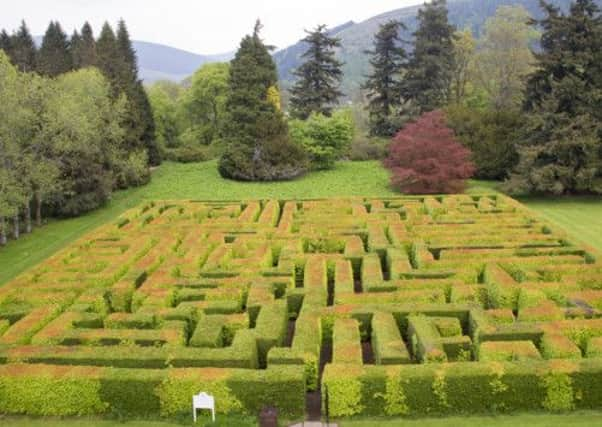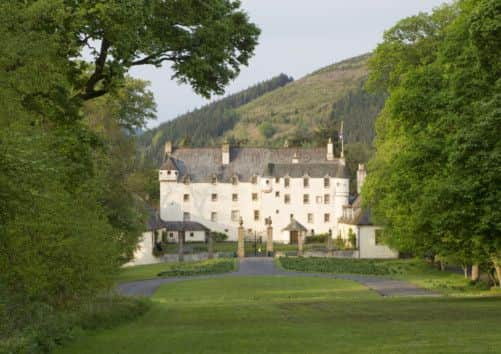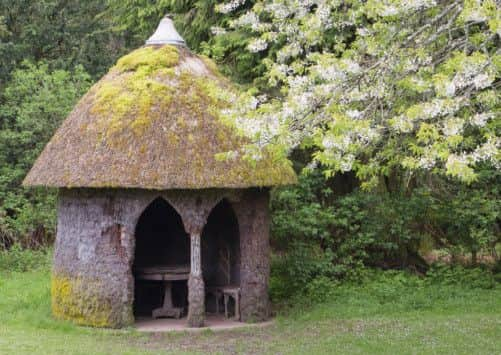Exploring the oldest inhabited house in Scotland


Add to this information the fact that Traquair is still lived in by the descendants of the Stuart family: Catherine Maxwell Stuart, 21st Lady of Traquair, her husband Mark and their four children, and a visit becomes irresistible.
In spring an added bonus is the chance to explore the 100 acre grounds. Less well known than the house, but equally intriguing, these were shaped by successive generations using Traquair’s striking setting close to the River Tweed with the Peebleshire hills in the background. Now, when carpets of bluebells stretch back under a canopy of fresh, lime-green foliage in the woodlands and romp around the ancient walled garden, the gardens take on a timeless quality.
Advertisement
Hide AdAdvertisement
Hide AdCatherine says there are no records to tell us how old the plantings of bluebells are or when the Hyacinthoides hispanica, more robust but less elegant than the native English bluebells, Hyacinthoides non-scripta, were introduced. Yet, the combination of varieties does much to add to the sea of blue.


“One of the particular pleasures at Traquair is its natural surroundings and absence of any formality,” she says. “The bluebells in the woodlands and creeping up amongst the trees are always a sure sign that summer has nearly arrived.”
The scene is set on arrival by the sight of the central lime avenue running from the Bear Gates – closed, awaiting the crowning of a Stuart king in Scotland – towards the house. This iconic avenue is especially lovely in June when the sun filters through the translucent, lime green foliage onto the mown grass below.
The policies were originally laid out by Charles, 5th Earl of Traquair when “confined to his estates” following his release from prison for his activities during the 1745 rebellion. The planting also owes much to the 8th Earl, who died in 1861. Catherine explains: “The 8th Earl was a great agricultural improver and was responsible for much of the woodland planting.”
Bound to the north and east by the Quair Burn and threaded with winding paths, the woods are punctuated with mature beech, oak, chestnut and Douglas Fir creating the perfect habitat for bluebells. “They certainly look natural in the woodlands and wilder areas of the grounds,” says Catherine.


Aside from bulbs – in addition to snowdrops, daffodils are also plentiful here, there are plenty of other surprises to be discovered as you explore the grounds: a stone doorway topped with a pair of bears, a sundial dating from 1649 and the charming Cupid’s Garden tucked into the side of the house.
Walking east from the courtyard in front of the house, you reach the old Croquet Lawn. A short walk past a series of fox-proof coops, housing exotic bantams and the pen, home to Catherine’s friendly pair of Kunekune pigs takes you to the maze. Laid out over 30 years ago on the ancient site of a 17th-century garden and planted with leylandii and beech, this is a proper maze in which you could easily, and quite happily, lose yourself.
To the east a Victorian heather hut marks the edge of the bluebell field, where drifts of blue run back into the woods, over the perimeter path, so much loved by Lady Louisa Stuart, and on to the side of the Quair Burn. On a warm spring morning this show-stopping, naturalistic display of thousands of bluebells is a joyful one.
Advertisement
Hide AdAdvertisement
Hide AdThe path leads along the side of the burn, where you might catch a glimpse of a heron, a moorhen or a mallard. On a good day you might even spot an otter in the Quair Burn. At the fork a left turn leads past a tall row of Butterbur trees, planted for the antihistamine properties of their bark and foliage and back towards the house. A right turn takes you further along the side of the burn, to its dramatic junction with the River Tweed. This slight detour rewards with a magical river view set against a backdrop of Border hills and perhaps a glimpse of a swan on the Well Pool, and a small island planted with elm.
The display of blue is perhaps at its most dramatic in the semi-formal setting of the Walled Garden. Situated to the right of the drive, just opposite the car park, this former traditional vegetable garden is now mostly laid down to grass punctuated with apple trees dating from the original 19th-century planting. Catherine explains: “Here, I assume the bluebells must have spread naturally during a time when the garden was disused. They now remain down the side of the beech hedge where the grass is left long.”
Blossom and bluebells are enhanced by an impressive metal statue of a horse, by artist Rachael Long, chosen from an exhibition of Borders’ Sculptors in the early 1990s. Catherine says: “Her work is all made from scrap metal and we particularly like the horse so we kept that one.”
The charm of this garden is that it tells the story of a family, and judging by the playground equipment and the joyful chatter of visiting children captivated by the pigs, a story set to continue for generations to come. “When the blossom and the bluebells are both out together in the Walled Garden the effect is stunning and brings back many happy memories of beer festivals we used to hold in the garden and now the Medieval Fayre,” says Catherine.
• Traquair House is on the B708, 1½ miles from Innerleithen, and is well signposted, www.traquair.co.uk, www.scotlandsgardens.org
When walking in the grounds stout shoes or boots are advised. The 1745 Cottage Restaurant is open for light lunches and afternoon teas.